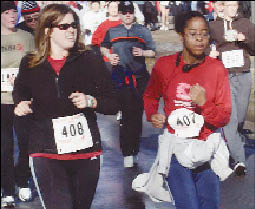 |
|
Shaping relationships: Mentor Katie Elden runs with her mentee, Tajh’et Horne. Photo: Photo courtesy of Bolder Options |
Minneapolis
(612) 379-BOLD
Objective: To introduce at-risk youth to healthy lifestyles and help them achieve athletic, social and learning goals by running and biking with mentors.
In a Nutshell: Youths develop relationships with adult mentors, built around one-year commitments to run or bike together once a week. They also participate in weekend races, bike rides and road runs, and do homework together for an hour each week.
A guest speaker program focuses on healthy lifestyles, including discussions about health, relationships and setting goals. One important lesson, says Executive Director Darrell Thompson, is that “you can expand your mind as well as expand your body.”
Where and When It Happens: Minneapolis and several nearby suburbs.
Who Started It and Who Runs It: Two members of the Minneapolis Jacyees Charitable Foundation created Bolder Options by adapting a Boulder, Colo., program with the same name that focused on helping youth avoid the juvenile justice system. Bill Steele and Phil Ramsour changed the model, formulated by two runners in the early 1990s, to fit Hennepin County, Minn. The group eventually became a nonprofit agency.
Thompson has served as executive director for the past 12 years. The staff includes 10 other full-time workers. The agency has more than 80 volunteer mentors.
Overcoming Obstacles: Thompson says the biggest struggle is recruiting mentors. Bolder Options works with local biking, running and athletic clubs to find mentors. It also finds local shoe stores and bike stores to provide discounts on shoes and equipment.
Cost: The annual budget is $1.5 million.
Who Pays: Thompson says about 30 percent of the money comes from the city and the state, including the state Youth Intervention Programs, with the remainder coming from individual donors and foundations, including the Bush and Otto Bremer foundations.
Youth Served: About 85 boys and girls, ages 10 to 14. Most are referred or assigned by youth-serving organizations, social workers and judges, or directly by the county in the case of first-time offenders and truants. They must be nonviolent, and must be either first-time offenders, truants, struggling in school or identified as needing positive adult role models.
Youth Turn-On: Not all youth are initially “super-excited,” Thompson says. “Typically, they get excited when they make the connection for having a healthy relationship with an adult figure. … Eventually, their grades improve, their attitudes improve, and then their home lives improve.”
Plus, each youth gets a new pair of sneakers from the program.
Youth Turn-Off: Some of the kids “are not excited about forced participation in a program like this,” Thompson says.
Research Shows: As youths go through the program, Bolder Options discusses their progress with their parents and peers, Thompson says. School officials tell Bold Options that the kids have better attendance. Self-reporting by youths shows an improvement in behavior after they leave the program, but there has been no independent study.
What Still Gets in the Way: Finding male mentors of color, and bringing in community partners, such as the city council, police department and schools, to provide various types of support, including meeting space.


























